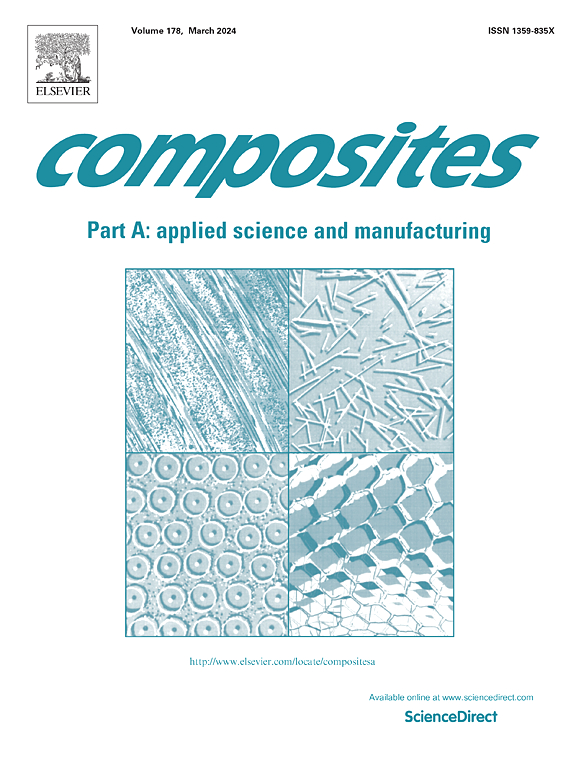Constructing harmonic grain distribution in graphene-reinforced Cu matrix composites for enhanced strength and electrical conductivity
IF 8.1
2区 材料科学
Q1 ENGINEERING, MANUFACTURING
Composites Part A: Applied Science and Manufacturing
Pub Date : 2025-07-22
DOI:10.1016/j.compositesa.2025.109200
引用次数: 0
Abstract
Graphene-reinforced copper matrix (Gr/Cu) composites typically exhibit high strength and electrical conductivity, with graphene playing a vital role in enhancing electrical conductivity. In this study, Gr/Cu composites with a novel harmonic grain structure were fabricated via in-situ graphene growth and hot-press sintering, and the synergistic effects of the Gr-network and Cu grains on the conductivity were systematically investigated. The harmonic unit consists of fine grains surrounding coarse grains, which is constructed by Gr-network distribution and grain growth. With an optimal harmonic configuration, the Gr/Cu composite achieves exceptional electrical conductivity of 102.70 % IACS, an ultimate tensile strength of 332.64 MPa, and an elongation of 28 %. The continuous three-dimensional Gr-network is crucial for ensuring superior electrical conductivity. Additionally, the harmonic structure minimizes carrier scattering and facilitates improved electrical conductivity. The unique grain distribution in the harmonic configuration also promotes strain delocalization and micro-crack blunting, leading to simultaneous improvements in physical and mechanical properties. These findings highlight the critical role of matrix microstructure and its cascading effect on electrical conductivity, providing a theoretical foundation for advancing conductive mechanisms in metal matrix composites (MMCs).

构建石墨烯增强铜基复合材料的谐波晶粒分布以增强其强度和导电性
石墨烯增强铜基复合材料通常具有高强度和导电性,石墨烯在提高导电性方面起着至关重要的作用。本研究通过原位石墨烯生长和热压烧结制备了具有新型谐波晶粒结构的Gr/Cu复合材料,并系统研究了Gr网络和Cu晶粒对导电性能的协同效应。谐波单元是由粗晶粒周围的细晶粒组成,由gr网络分布和晶粒生长共同构成。在最佳谐波结构下,Gr/Cu复合材料的电导率达到102.70% IACS,极限抗拉强度为332.64 MPa,延伸率为28%。连续的三维gr网络是保证优异导电性的关键。此外,谐波结构最大限度地减少载流子散射,促进提高导电性。谐波结构中独特的晶粒分布也促进了应变离域和微裂纹钝化,从而同时改善了物理力学性能。这些发现突出了基体微观结构及其级联效应对导电性能的重要作用,为进一步研究金属基复合材料的导电机理提供了理论基础。
本文章由计算机程序翻译,如有差异,请以英文原文为准。
求助全文
约1分钟内获得全文
求助全文
来源期刊

Composites Part A: Applied Science and Manufacturing
工程技术-材料科学:复合
CiteScore
15.20
自引率
5.70%
发文量
492
审稿时长
30 days
期刊介绍:
Composites Part A: Applied Science and Manufacturing is a comprehensive journal that publishes original research papers, review articles, case studies, short communications, and letters covering various aspects of composite materials science and technology. This includes fibrous and particulate reinforcements in polymeric, metallic, and ceramic matrices, as well as 'natural' composites like wood and biological materials. The journal addresses topics such as properties, design, and manufacture of reinforcing fibers and particles, novel architectures and concepts, multifunctional composites, advancements in fabrication and processing, manufacturing science, process modeling, experimental mechanics, microstructural characterization, interfaces, prediction and measurement of mechanical, physical, and chemical behavior, and performance in service. Additionally, articles on economic and commercial aspects, design, and case studies are welcomed. All submissions undergo rigorous peer review to ensure they contribute significantly and innovatively, maintaining high standards for content and presentation. The editorial team aims to expedite the review process for prompt publication.
 求助内容:
求助内容: 应助结果提醒方式:
应助结果提醒方式:


